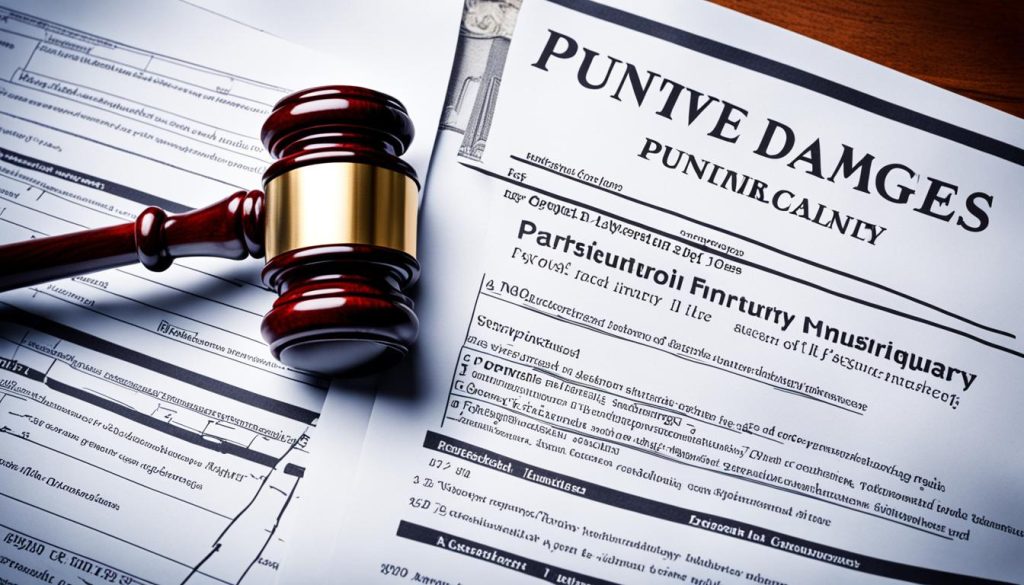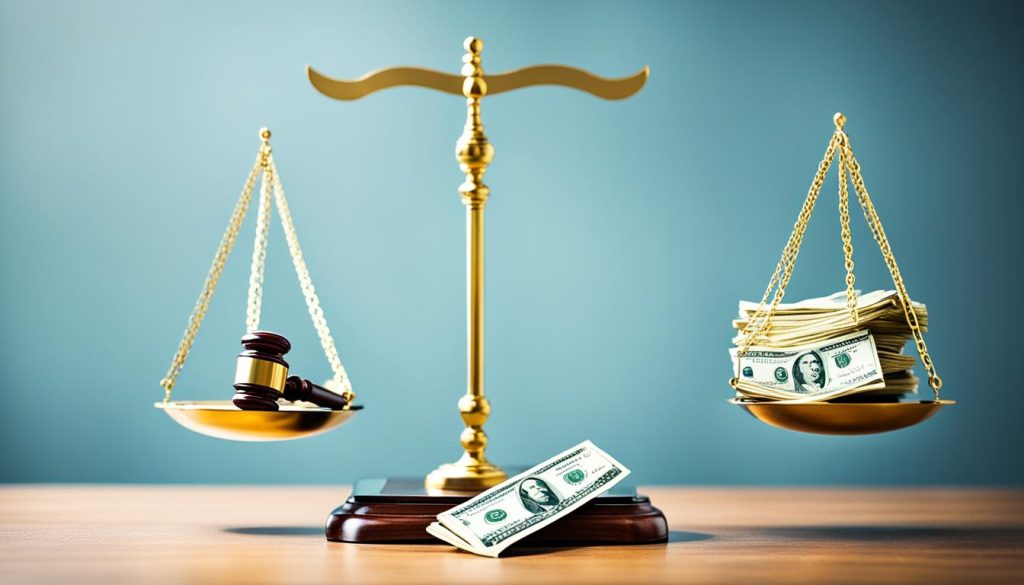In the complex world of personal injury lawsuits, punitive damages often spark interest and debate. If you’ve been hurt, you might be able to get different kinds of legal help, including punitive damages. Knowing about punitive damages is key to getting the right legal help and making sure you get the compensation you need1.
Punitive damages, also known as exemplary damages, are a special kind of compensation. They are given on top of the usual damages in personal injury cases1. These damages aim to punish the person who was at fault and stop them from doing it again1.
These damages are given when someone acted recklessly, with bad intent, or caused harm on purpose1. Figuring out how much punitive damages you get looks at how bad the person’s actions were, the harm done, and their money situation1. The amount can be anything from a few thousand dollars to millions, based on how bad the case is1.
Key Takeaways
- Punitive damages are a special kind of compensation that go beyond usual damages in personal injury cases.
- Punitive damages are given to punish the defendant and stop similar actions in the future.
- Punitive damages are usually given in cases of reckless, malicious, or intentional actions by the defendant.
- Figuring out punitive damages looks at how bad the actions were, the harm caused, and the defendant’s money situation.
- Punitive damages can be from a few thousand to millions of dollars, based on the case’s severity.
What Are Punitive Damages?
Meaning and Purpose of Punitive Damages
Punitive damages don’t aim to make the injured whole like compensatory damages do2. They are meant to punish the defendant for their bad actions and stop others from doing the same2. These damages are given in cases like personal injury or medical malpractice, not in contract disputes2.
Compensatory damages help the plaintiff by covering their losses, like medical bills and lost wages2. Punitive damages, however, are a financial hit on the defendant to punish and prevent bad behavior2.
Punitive damages are given only when the defendant’s actions were very bad, like grossly negligent or intentional3. The jury decides how much, looking at how bad the defendant was, the need to stop others, the defendant’s wealth, and the plaintiff’s injuries3.
Even though punitive damages can be a strong way to hold wrongdoers accountable, there are limits3. Many states set a cap on how much punitive damages can be, and the Supreme Court has also said when these damages might be too much3.
Punitive damages are key in the American legal system, sending a clear message that bad behavior won’t be ignored2. They act as a warning and make sure people and companies are more careful and responsible234.
Punitive Damages vs. Compensatory Damages
In personal injury cases, there are two main types of damages: compensatory and punitive. Compensatory damages help cover the plaintiff’s actual losses from someone else’s negligence5. These losses can be medical bills, future costs, or damage to property5. There are two kinds of compensatory damages: special for specific losses and general for things like emotional pain and suffering5.
Punitive damages, on the other hand, are meant to punish the defendant, not just compensate the plaintiff5. They are given when the defendant acted with intent or extreme carelessness6. Punitive damages are less common than compensatory ones in injury claims5. They are usually given in serious cases like medical mistakes or product issues5.
Compensatory damages focus on the plaintiff’s losses, while punitive damages are up to the court’s choice6. Punitive damages are usually a set amount above the compensatory damages6. The rules for punitive damages vary by state, with some states more likely to award them6.
To sum up, compensatory damages aim to put the plaintiff back in their financial and emotional state before the injury. Punitive damages are meant to punish the defendant and prevent similar actions in the future. Knowing the difference between these damages is key for injury victims seeking fair compensation7.
When Are Punitive Damages Awarded?
Requirements for Punitive Damages in Personal Injury Cases
Punitive damages are more than just compensation. They are given when someone’s actions were very bad, showing intent, malice, or reckless behavior8. Courts usually don’t like to give punitive damages but might in serious cases8.
Examples of when punitive damages might be given include a drug company selling dangerous products without warnings, a church moving an abusive priest, an apartment complex not fixing a broken pool gate, or a drunk driver causing a fatal crash8. These actions show a big disregard for others’ safety, so more punishment is needed8.
Punitive damages are for the worst cases, where someone acted on purpose, with bad intent, or without caring about the outcome8. The goal is to stop bad behavior by punishing the wrongdoer, not just to help the injured8.
“Punitive damages are not given for simple mistakes or errors. They are given for actions that are very wrong, showing an evil motive or no care for others’ rights.”
In Ohio, there’s a limit on how much punitive damages someone can get, up to twice the compensatory damages or $350,0008. You must file a personal injury lawsuit in Ohio within two years of the accident to claim damages8.
Punitive damages are a strong tool in law, used carefully to punish serious wrongs and prevent them from happening again. They need strong evidence to be given, making sure they’re only for the most extreme cases of bad actions898.
Factors Influencing Punitive Damages
Punitive damages, also known as exemplary damages, aim to set an example and stop others from doing wrong10. These damages are given in a small number of cases (3% to 5%) but play a big role in stopping bad behavior10.
Many things affect whether punitive damages are given in personal injury cases. If the defendant meant to harm someone or acted very carelessly, this matters a lot11. The courts look at how bad the defendant’s actions were, the harm caused, and if the damages will stop others from doing the same10.
Other things can change how much punitive damages are given. This includes the defendant’s wealth, if they’ve done this before, how much money the plaintiff got, and if it’s important to stop this behavior10. The aim is to make sure really bad actions are punished strongly. This helps with justice and stops others from doing the same thing10.

“Punitive damages serve both a retributive function, addressing the moral outrage of wrongs committed, and a preventative function, reducing the likelihood of repeated misconduct.”
punitive damages, personal injury, legal compensation
Big punitive damages cases often grab headlines, but they’re rare in personal injury lawsuits12. Most people don’t go after punitive damages, and when they do, they win only about 30% of the time12. Getting punitive damages is tough; you must show the defendant acted very badly.
In personal injury cases, the main goal is to get back what the injured person lost financially before the accident13. This includes money for medical bills, rehab, lost wages, and fixing damaged property13. It also covers non-money losses like pain, suffering, and enjoying life less13.
Punitive damages, or exemplary damages, are not often given in personal injury cases13. They’re meant to punish bad behavior and stop it from happening again13. How much punitive damages you get depends on how bad the misconduct was, the harm done, the defendant’s wealth, and fairness to the actual damages13.
| Type of Damages | Purpose | Examples |
|---|---|---|
| Special Damages | Restore financial state | Medical bills, rehabilitation, lost earnings, property damage |
| General Damages | Compensate non-economic impacts | Pain, suffering, loss of enjoyment |
| Punitive Damages | Punish and deter egregious behavior | Awarded for acts like aggravated battery, fraud, sexual assault |
Remember, laws for punitive damages change by place13. These damages punish reckless actions but aren’t given in every injury case13. Victims can ask for different amounts for damages, and the final amount is usually decided by talking or going to court14.
To sum up, while punitive damages get a lot of attention, most personal injury cases focus on getting back what the victim lost and justice for their pain121314. Knowing about the different damages and legal rules is key for anyone dealing with personal injury claims and seeking the right legal help.
“The law of damages is essential to the administration of justice, and it is the duty of the courts to see that just compensation is awarded.”
– Justice Oliver Wendell Holmes
Limitations on Punitive Damages
Punitive damages play a key role in the legal system but have limits to ensure they are used fairly15. In the U.S., about 5% of verdicts include punitive damages15. Yet, the U.S. Department of Justice found that only 30% of trials where punitive damages were sought got them15.
State and Federal Caps on Punitive Damages Awards
There’s no single cap on punitive damages across the U.S15. Many states set their own limits, like capping damages at a certain amount or a percentage of the defendant’s wealth15. Some places also have a split-recovery rule, where the plaintiff and state share punitive damages, often 50% to 75%15.
The Supreme Court has also set guidelines for punitive damages15. It hasn’t given a specific test for awarding them, but advises courts to look at the defendant’s actions and the damages ratio15. In State Farm v. Campbell (2003), the Court said punitive damages should usually not be more than 10 times compensatory damages, except in extreme cases15.

These rules and guidelines ensure punitive damages are given wisely and match the harm done15. They help balance deterrence and fairness, protecting both sides from punitive damages abuse151617.
Tax Treatment of Punitive Damages
Understanding taxes is key when dealing with personal injury settlements. Punitive damages are taxed as income, but not compensatory damages for physical injuries1819.
Punitive damages come when the defendant’s actions were very bad, like texting while driving or making a dangerous product19. The court looks at how bad the actions were and the defendant’s wealth to set the damages19.
On the other hand, damages for physical injuries aren’t taxed at the federal level18. But, some damages like lost wages, past medical bills, and interest on the settlement might be taxed18.
In wrongful death cases, punitive damages might not be taxed in some places18. This is because there’s no money to make up for lost earnings or other losses18.
Tax rules for personal injury settlements can differ by state and federal laws18. It’s wise to talk to a tax expert to know your tax duties from your settlement18.
“Punitive damages are considered taxable income, unlike compensatory damages for physical injuries which are typically excluded from taxable income.”
In short, damages for physical injuries aren’t taxed, but punitive damages are. Yet, wrongful death claims might have special rules. Always get tax advice to follow the law and avoid extra taxes181920.
Conclusion
Punitive damages often grab headlines but are rare in personal injury and business cases21. You need to show the defendant’s actions were very bad, like intentional wrongs or extreme carelessness21. The jury decides if punitive damages are given, looking at each case’s details22.
It’s key to talk to a skilled personal injury lawyer to see if you might get punitive damages22. They can look at your case and tell you if you might get this kind of compensation22. Big punitive damage awards do happen, like in Liebeck v. McDonald’s and MGA v. Mattel, but they’re not common2221. Your lawyer will tell you about any limits on punitive damages in your state, like Texas’ rules23.
The main aim of punitive damages is to punish the wrongdoer and stop others from doing the same23. Knowing about punitive damages in personal injury law helps you make smart choices about your case.
FAQ
What are punitive damages?
Punitive damages, also called exemplary damages, are given to stop the defendant and others from doing the same thing. They are meant to punish the defendant. This is done to set an example for the public.
How do punitive damages differ from compensatory damages?
Punitive damages are given to punish the wrongdoer, not to make the injured party whole. They are given in tort law cases, like personal injury or medical malpractice. They are not given in contractual disputes.
What is required to prove liability for punitive damages?
To prove liability for compensatory damages, the plaintiff must show the defendant didn’t meet the “reasonable person” standard. For punitive damages, the plaintiff must prove the defendant acted with intent to harm or with gross negligence/recklessness.
When are punitive damages awarded in personal injury cases?
Punitive damages are awarded when the defendant acted willfully, maliciously, oppressively, fraudulently, or recklessly. Examples include a drug maker selling harmful drugs without warnings, a religious group moving an abusive clergyman, an apartment complex not fixing a broken pool gate with kids around, or a drunk driver causing a fatal crash with a DUI record.
What factors influence the amount of punitive damages awarded?
Key factors include the defendant’s intent to harm, gross negligence or recklessness, how bad the defendant’s actions were, and if it’s enough to deter others. Courts also look at if the punitive damages are fair compared to the harm the plaintiff suffered.
How rare are punitive damages in personal injury cases?
Punitive damages are not common, even though big awards get a lot of attention. Plaintiffs don’t often go for punitive damages. When they do, punitive damages are given in about 30% of cases where the plaintiff wins.
Are there any limitations on punitive damages awards?
There’s no limit on punitive damages, but many states have their own limits. Some cap awards at a certain amount or percentage of the defendant’s wealth. Some states take part of the punitive award. The Supreme Court says punitive damages should usually not be more than a few times the compensatory damages, unless it’s a very serious case.
How are punitive damages taxed?
Punitive damages are taxed as “Other income,” unlike compensatory damages for physical injury which aren’t taxed. But, punitive damages in wrongful death claims might not be taxed in some states where only punitive damages can be given in such cases.
Source Links
- Understanding Punitive Damages in Personal Injury Claims
- Compensatory Vs Punitive Damages | Knowing The Difference
- Punitive Damages in Personal Injury Lawsuits
- What Are Punitive Damages? Purpose, Cap, Calculation, and Example
- What Are the Differences Between Compensatory and Punitive Damages? | Roden Law
- Differences Between Punitive and Compensatory Damages
- Compensatory vs. Punitive Damages
- Compensatory Damages vs. Punitive Damages
- Punitive, Compensatory damages Vs. Pain & Suffering
- What Are Punitive Damages? A Comprehensive Overview
- What are Punitive Damages in Personal Injury Claims?
- Types of Damages in Personal Injury Lawsuits
- Types Of Damages In Personal Injury Cases
- The Three Different Types of Compensatory Damages Explained | Wilshire Law Firm
- punitive damages
- Do Punitive Damages Apply to Personal Injury? | Eric Ratinoff Law Corp
- What Are Punitive Damages and When Are You Entitled to Them?
- Are Personal Injury Settlements Taxable? 2024 Guide
- Are Punitive Damages Taxable? Here’s What You Need to Know
- Are Personal Injury Settlements Taxable?: 5 Tax Implications
- What Are Punitive Damages?
- What Are Punitive Damages? | The Pendergrass Law Firm, PC
- What Are Punitive Damages, And How Do They Differ From Compensatory Damages? | Cain Firm

